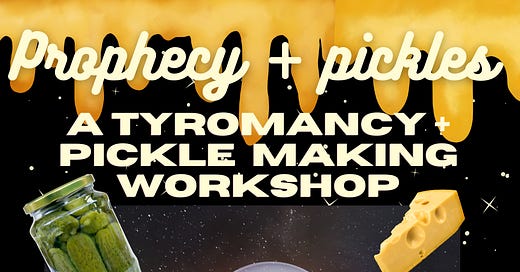The magic of fermentation
Pickling and witchcraft past and present, plus a free intention setting journal
Beginning with gratitude, and a gift:
You know I love a good journaling prompt. Recently, when asked how I want my writing career and my business to look in 5-10 years, I struggled to articulate what exactly I wanted.
I know what impact I want to have, and the kinds of things I want to be doing, but the shape of each in practical terms? Not quite as clear.
So, I meditated and reflected, and came up with these journal prompts which use abundance and your biggest impact and greatest work as guideposts for future planning.
I plan to dip into answering them myself this week: The new moon (May 7) is the perfect time to work with intentions and future plans, but these prompts will serve you well whenever you decide to use them. Enjoy!
On to the pickles!
This is an adaptation from my recent class on fermentation + witchcraft with Jennifer Billock: Shared here for my readers who want to learn more about how people tie the two together in their magical practices.
I’d love to hear how you connect magic and fermentation (however that looks) in the comments!
The magic of fermentation
Fermentation has long been associated with magic, otherworldly realms, and power, and it has a long association with deities (like the Viking mead of poetry and inspiration and Cerridwen's brew of knowledge and wisdom).
And our pop culture image of witches, standing over a bubbling cauldron wearing a big hat, with a broomstick and a cat, is actually based in fermentation too:
Women were, historically, the ones usually in charge of brewing beer for their communities in western Europe. It was one of the few ways women could earn money and become financially independent from men.
But in the 1600s and 1700s, men decided they wanted to take over brewing, and so formed professional brewers guilds that women couldn't join. And, they started a smear campaign against women brewers so the public wouldn't trust them. Being called a witch at that time was a pretty surefire career killer, so women soon lost the ability to brew professionally and also lost one of the few avenues they had to make money.
Women brewers' cauldrons of wort and beer, the broom they used to sweep away grain, their cats that kept rodents from the grain stores, and the big hats they wore so they were visible on the street for those looking to buy their wares, all became symbols of witchcraft but are, in fact, symbols of women's autonomy and independence. But of course the two often go hand in hand.
Today, women make up something like 2% of all professional brewers, so even now we aren't anywhere near the number of women in the industry we once had (you can also see this piece where I interview several women in brewing and discuss that history).
Women brewers being cast as witches is one of many examples of witchcraft being used as (at best) negative PR and (more often) as a death sentence for community members who were considered different in some way. Fermentation history, as with any food's history, is filled with stories of abuse, manipulation, and oppression. This is just one example.
Modern witchcraft and ancient ferments
As any fermenter knows, fermentation itself is truly magical, and so it's no surprise that many kitchen witches today have been returning to it as a way to practice our art. The magic of making ferments is empowering, a way to reconnect with traditions and to create a future story for fermentation that's independent of historic attempts to destroy the livelihoods of the businesswomen who relied on it.
Fermentation is a really powerful, fun, beautiful way to connect more deeply to your food and your craft. This isn’t all just fun and fluff, these are practices rooted deep in historical traditions. And it's all about transformation and community too, and thinking of our ferments as transformative communities is a practice rooted in scientific fact.
Whether you are an active practitioner of magic, or just curious how fermentation fits into the world of magic, I've written this guide to spark your curiosity and perhaps some inspiration.
One thing I like about this work is that in setting an intention with a spell, you're already aligning yourself to take action towards that intention (this is true of intention setting generally). So, you're the secret magic ingredient!
If you want to learn more, make sure to check out this virtual class with myself and tyromancy (cheese divination) expert Jen Billock (bonus: You'll get to see a very sweet proposal from my fiancé, a wonderful surprise while we were teaching, and frankly very fitting place for me to be proposed to!)
Keep reading with a 7-day free trial
Subscribe to Root: Historic Food for the Modern World to keep reading this post and get 7 days of free access to the full post archives.





